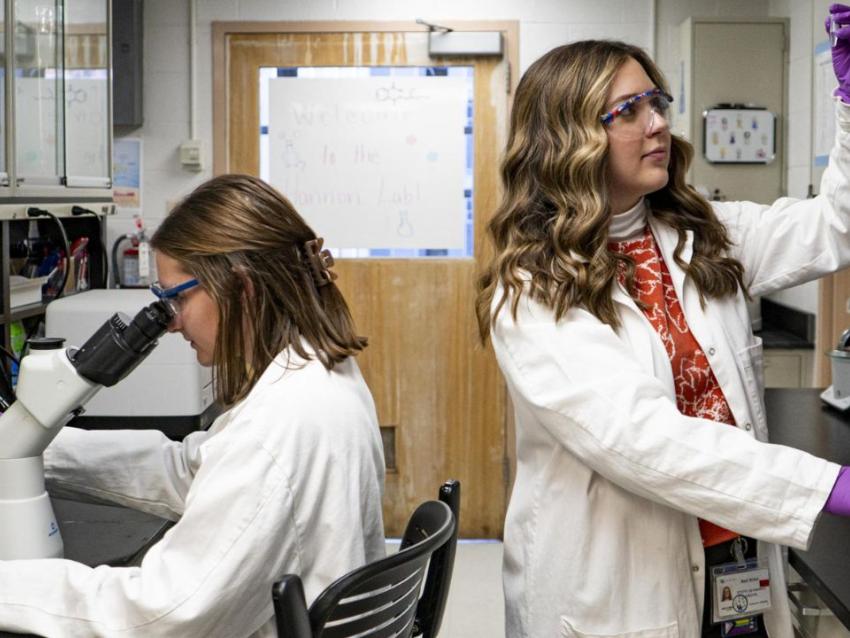
Research, growth and connection
A cork board hangs on the door with the words “The Hannon Laboratory” written in pink and white surrounded by colorful drawings and photos of students.
Inside, white fluorescent lights hang from the ceiling, and focused gazes are directed at different samples accompanied by the steady beeping of a machine.
The concentration in the room is palpable.
University of Kentucky students work on their research wearing white lab coats, gloves and protective goggles. They operate advanced microscopes, measure pH levels and use pipettes to transfer cell samples.
This year Madi Wilson, a senior majoring in human health sciences on the pre-physician assistant track, and Caroline Harper, a senior majoring in agriculture and medical biotechnology, have been selected to attend Posters-at-the-Capitol with 11 other undergraduate students.
The event shows a poster of the students’ experience in research at the state capitol. This allows lawmakers to see the role undergraduate research plays in the education of college students.
The research this team will present is called “Exposure to an Environmentally Relevant Phthalate Mixture Inhibits Ovulation By Impairing Prostaglandin Function in the Mouse Ovary.” This research concerns the impact of phthalates, which are used as solvents and plasticizers in much of the plastic humans are exposed to, on women’s ovulation.
“I feel like, as a woman, women’s health is really important to me, knowing and understanding the things that impact our bodies is something everyone should be informed about,” Harper said.
For Harper, research is important to her because it allows students to educate themselves on topics other than those they are learning in class.
Being in the lab has greatly impacted the students who work here, strengthening their desire to go further into the medical field, Harper said.
For Wilson, who has been diagnosed with Type 1 diabetes, learning more about endocrinology allowed her to find her calling to be a pediatric endocrinology physician assistant.
“Our lab focuses on women’s reproductive health and also endocrinology. I knew I wanted to parallel the research in the lab to a future career in healthcare,” Wilson said.
Research has been a big part of Wilson’s college experience, allowing her to practice skills for her future career such as public speaking, teamwork and communication. Additionally, it has taught her many valuable life skills such as friendship, support and dedication.
“I would not be the person I am today without the skills learned from the Hannon Lab, ” Wilson said.
The opportunity to participate at Posters-at-the-Capitol merges students’ passions with their future objectives and career goals. For Harper, the event will provide her an opportunity to network with potential future colleagues as she hopes to work in a policy-based role after graduation.
“This research strengthens the fact that in the future I want to work for women’s health and their reproductive health,” Harper said.
In the future, she plans to move to Washington, D.C. to work in settings where she can learn about policy and how it is created and work to advocate for equitable healthcare policies.
The enthusiasm and expectations these students have for this event take us back to where it all began: the Hannon Lab.
This lab welcomes undergraduate and graduate students, as well as technicians, for research support.
According to Harper, some of the students in the Hannon Lab have been here since their early years in college and have been working here during summers and all their semesters.
“I was on the pre-medicine track and research was required, that’s how I found the Hannon Lab,” Harper said. “Even if I am not doing medicine anymore, I am still grateful for everything I have learned here.”
However, doing research can also bring some challenges as research demands significant time commitments. Wilson said some students spend around 14 hours a week working at the lab, sometimes even going there twice a week for seven to eight hours per day.
Patrick Hannon, assistant professor in the Department of Obstetrics and Gynecology at UK, namesake of the lab and the girls’ mentor, said that when students first join the lab they face numerous challenges.
“Learning all the complex academic background and technical skills that we use in the lab takes some time to grasp,” Hannon said.
However, for Harper being able to learn more about the concepts and their relevance has helped her understand the purpose of their research.
According to Harper, as undergraduate students, they do a lot of collaboration while working in the lab, working like a team and seeking help from Hannon and other graduate students.
“The community that I have found here in the lab are one of the people I have found more fun to work with. We do a lot of lab bonding and it’s just a very supportive environment,” Harper said.
Going to baseball games, having lunches outdoors, escape rooms, axe throwing and pottery painting have been some of the bonding events we have done so far, Wilson said.
These activities help them connect with each other, meet new members and create friendships.
“I think of this lab as my family and cannot wait to see what they all do in life,” Wilson said.